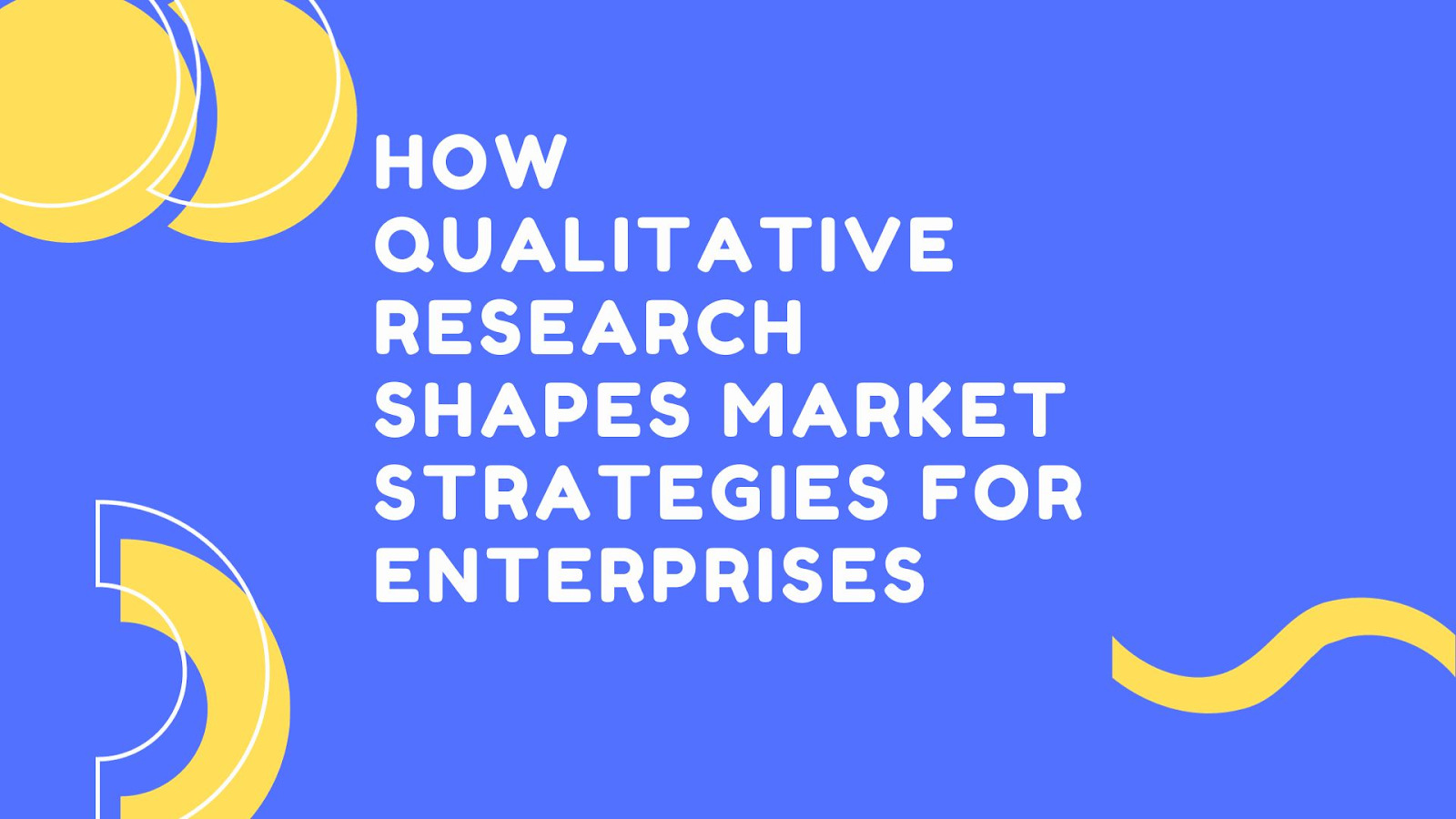How Qualitative Research Shapes Market Strategies For Enterprises

Businesses want to understand who likes their products and why. Quantitative data provides basic information such as age and location However, to truly understand what drives people, delving deeper is essential.
What’s Inside This Guide
This guide is here to help you learn how to do that. We’ll talk about ways to find out more about your customers and their feelings. You’ll find out about old and new tricks to get this important information. This guide will empower your business to make more informed decisions.
The Need For Qualitative Insights
Quantitative data delivers useful aggregate views of markets through metrics like:
- Demographics – age, gender, income, job role
- Psychographics – attitudes, interests, values
- Firmographics – industry, employees, revenue
- Past behaviors – purchases, clicks, downloads
However, the human context behind these numbers often remains elusive. Qualitative techniques excel in illuminating this human context.
Qualitative Research Methodologies
There are four key methods for engaging with people to understand their thoughts and feelings:
- Interviews: This is like having a chat with someone. You ask them questions about what they think and feel about things like products, messages, and problems they face.
- Focus Groups: A group of 6 to 10 people engages in a discussion about specific topics. By listening to them, we can understand what they all have in common. This method provides insight into shared perspectives and commonalities among participants and is a key element of qualitative market research.
- Ethnographic Research: This means watching people in their real-life situations. We see how they behave, who they talk to, and what’s around them to really understand their world.
- User Testing: Here, people use products, like physical things or apps, while researchers watch. We see what’s easy to use and what’s not, so we can make things better.
These four methods significantly enhance our understanding of people’s needs and wants.
Uncovering Strategic Consumer Motivations
Skilled qualitative research reveals core consumer psychology and jobs to be done that shape strategies. Learnings include:
Pain Points: A deeper understanding of the frustrations consumers encounter in fulfilling key tasks or achieving goals. Unmet needs to target.
Decision Influencers – Which factors most sway product evaluations and purchase decisions? Rational, emotional, social, environmental or circumstantial motivations?
Brand Perceptions –. What attributes, personalities and values do target consumers associate with competitive brands? Where should your brand differentiate?
Moments That Matter: Identify when and how your offering integrates into consumers’ daily routines or essential workflows. Where can your brand enhance experiences?
Vocabulary and Framing – How do audiences describe needs and talk about your product category? What language best resonates?
Articulating these consumer truths and mindsets provides direction for positioning brands in meaningful ways.
Related: What Is Market Intelligence vs. Market Research?
Strategic Outcomes From Qualitative Insights
Getting deep qualitative insights directly from consumers through observational techniques like ethnography and focus groups can transform business strategies and startup success. By understanding the full context behind people’s behaviors, motivations, pain points, and unmet needs, brands gain immense strategic guidance. Here are some of the most valuable strategic outcomes that derive from well-conducted qualitative research:
Product Development
Qualitative insights precisely identify the features or innovations that would add maximum value for consumers. Identifying where consumers struggle or devise workarounds in current products guides the prioritization of solutions in future product roadmaps and development sprints.
Observations reveal which usability barriers frustrate consumers the most. This focuses engineering efforts on innovations that improve core jobs to be done. Qualitative insights ensure product teams build what users really want next rather than relying on internal assumptions.
Category Expansion
Ethnographic market research also uncovers adjacent verticals and use cases where people’s jobs to be done closely align with your brand’s core capabilities.
Observing consumers’ range of outcomes and the variety of products or services hired for similar goals reveals new category opportunities a brand is well-positioned to expand into. Needs fulfilled by other means often represent promising new target segments for a brand, enabled by its existing strengths and assets.
Marketing Messaging
Seeing firsthand which pain points matter most to consumers and listening to the exact language and framing they use to describe their struggles informs crafting resonant and compelling marketing messages. Communications grounded in real customer vocabulary around core priorities prove much more engaging than generic corporate slogans. Creative teams should leverage direct quotes and expressions consumers use to describe their solution benefits.
Content Planning
Uncovering consumers’ deeper motivations, life moments, decision factors and thought processes allows content strategists to develop materials that speak directly to the shared truths of target audiences. Content built around real volunteer stories, perspectives, and narratives forges a powerful connection lacking in generic content.
Customer Journey Mapping
Deeply studying how people interact with a brand across environments, routines, devices, touchpoints, and more via ethnography highlights opportunities to refine end-to-end experiences. Seeing where disconnects, friction, or breakdowns arise in serving consumers guides mapping optimized journeys tailored to natural consumer workflows. Fixing journey pain points strengthens retention.
Sales Enablement
Equipping sales teams with knowledge of customers’ underlying drives, values, thought processes and language derived from qualitative research helps them make authentic connections with prospects and convey value in compelling ways. Sales conversations become more productive when grounded in the real psychology behind consumers’ needs.
Deriving strategy directly from contextual human-centered insights gives brands an immense advantage. While quantitative data shows what is happening, qualitative insights reveal the all-important why behind behaviors, perceptions, and decisions. This separates breakthrough companies from struggling competitors.
Text Analysis For Scalable Qualitative Insights
Advances in natural language processing and machine learning are enabling computers to extract qualitative insights from written text in transformative ways. The ability to swiftly parse and analyze large volumes of unstructured text data enables efficient derivation of contextual findings at scale. Here are some of the most valuable applications of text analytics innovation:
Customer Feedback Analysis
For major brands, managing the vast volume of unstructured text feedback from sources such as call center logs, customer surveys, reviews, social media, and emails is a significant challenge. There are simply too many customer verbatim comments for human teams to manually compile and make sense of.
Text analysis software can ingest these massive textual datasets and identify significant themes, trends, recurring complaints, suggested improvements, and other critical insights. This empowers businesses to leverage all that feedback to improve offerings based on what their customers say at scale.
Competitive Intelligence
Text analytics tools enable analysts to rapidly process large amounts of text data from competitors, encompassing executive statements, investment disclosures, public speeches, patents, job postings, and Glassdoor reviews, among others.
This automates gathering intelligence on competitor priorities, challenges, strategies, and growth opportunities from their own written words. Text analysis allows deriving insights from competitor public messaging and internal dialogue cost-effectively.
Market Research Synthesis
Lengthy market research reports and consumer surveys containing open-ended written responses can be rapidly analyzed using text analytics solutions. They can pinpoint key consumer trends, motivations, pain points, switching triggers, priorities, and other valuable insights from massive textual data at speeds impossible for humans alone. This saves many hours of manual reading for analysts.
Social Listening
The tidal wave of ongoing social media conversations poses a huge challenge for brands to monitor and understand. But text analytics tools can quickly parse the sentiment, trends, complaints, product preferences, and brand perceptions within massive social datasets. This unlocks actionable consumer and market insights hidden within unstructured social data.
The common theme is using advanced text analysis to turn daunting volumes of qualitative text data into a strategic asset that reveals customer, competitor and market insights faster than previously feasible.
Video Analytics: The Next Frontier
Numerous videos are created by everyday people on social media and review websites. These videos are like a treasure because they tell us what people think in a very detailed way. New computer technology can help us understand these videos.
Learning From Reviews And Unboxings
We can use this technology to figure out what people like and don’t like about products. We can learn about the problems they have and what they wish for just by looking at videos where they talk about the things they bought.
Hearing From Customers
At times, several individuals discuss a topic together in a video. Computers can watch many of these videos and tell us what’s important to these customers. This is much faster than watching all the videos by ourselves.
Checking Out The Competition
We can also use this technology to see how people react to videos made by other companies. This helps us know what’s good or not so good in their videos.
Quickly Understanding Focus Groups
Sometimes many people sit and talk about something in a video. Computational tools can assist in identifying key points from these discussions, eliminating the need to watch the entire content. This saves a lot of time.
Video analytics unlock a trove of qualitative data from authentic user-generated visual content.
Blending Qualitative And Quantitative Research
For comprehensive audience understanding, blend qualitative and quantitative data:
- Explore quantitative survey results in more detail through follow-up focus groups.
- Mine qualitative social media data to find target audience subsets for quantitative polling.
- Extract key themes from interviews to inform quantitative survey design.
- Develop quantitative segmentation strategies based on qualitative motivations and identify jobs to be done.
When integrated effectively, these two approaches collectively become far more powerful than when used in isolation.
Overcoming Resistance To Qualitative Research
Leaders sometimes resist qualitative methods due to perceptions they are:
Expensive – Automated analytics minimize costs. Targeted small focus groups yield huge insights.
Non-Representative – When combined with quantitative data for context, deep dives provide missing strategic texture.
Just Opinions – Skilled qualitative experts identify underlying motivations and jobs to be done that shape lasting consumer behavior.
Biased – Researchers must watch for projection of their own biases. Customer frame of reference matters.
Hard to Scale – New text and video analytics innovations enable qualitative understanding at scale.
Position qualitative insights as a critical missing piece of the puzzle to secure buy-in.
Key Takeaways
- Qualitative research reveals strategic consumer motivations and jobs-to-be-done hidden by quantitative data.
- Core methodologies like focus groups, interviews and ethnography uncover key behavioral drivers.
- Text and video analytics enable deriving qualitative insights from user feedback at scale.
- Integrating qualitative and quantitative data provides complete market understanding.
With qualitative intelligence guiding strategies, brands can forge enduring emotional connections beyond transactions. Quantitative data demonstrates what consumers are doing. Qualitative insights illuminate why. Collectively, they illuminate a path towards intimately serving target audiences.
FAQs
How much does executing qualitative research cost?
Costs range from $25K for a few focus groups, to $35K for ethnographic studies, and up to $100K+ for large-scale interview campaigns. Text and video analytics provide more affordable scalability.
What skills make an excellent qualitative researcher?
Empathy, trust-building, body language reading, patience allowing silence, grasp of psychology, active listening, distilling insights from volumes of data.
How large should focus groups be?
6-10 participants. Too few limits diversity of thought. Too many prevents everyone from sharing observations.
Should quantitative surveys always follow qualitative research?
Not necessarily – the sequence depends on goals. Begin with quantitative methods to gauge the opportunity before embarking on targeted qualitative research. Or start qualitatively to explore behaviors for survey design. Integrate insights from both continually.
Final Thoughts
While challenging to master, qualitative research provides indispensable strategic guidance. To connect with what makes humans tick. Overlooked qualitative truths unlock growth potential.
Read Also:



























